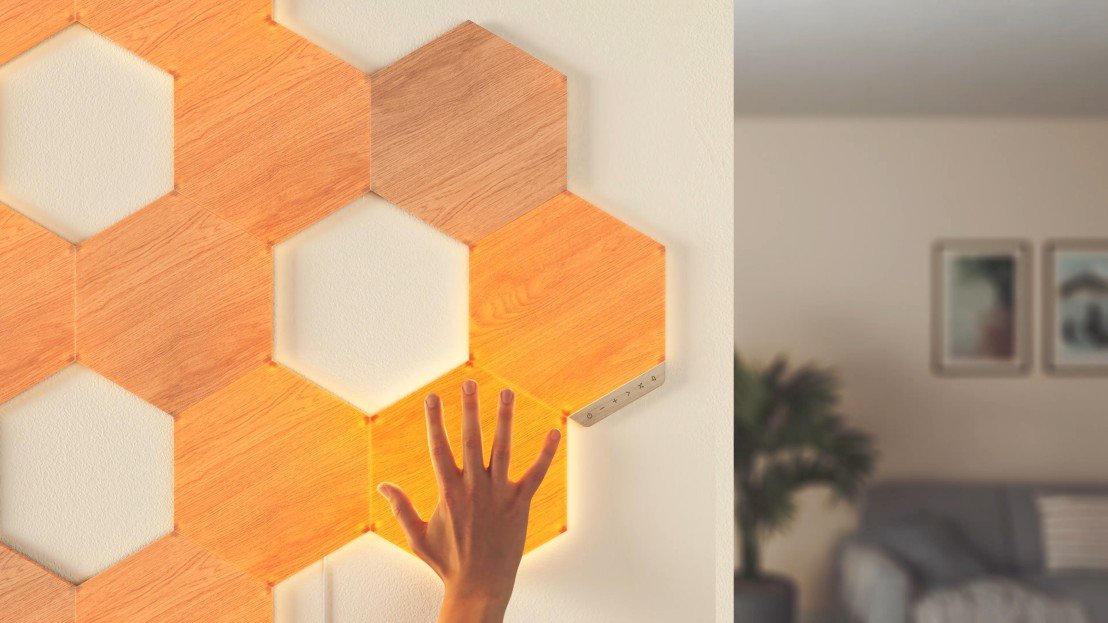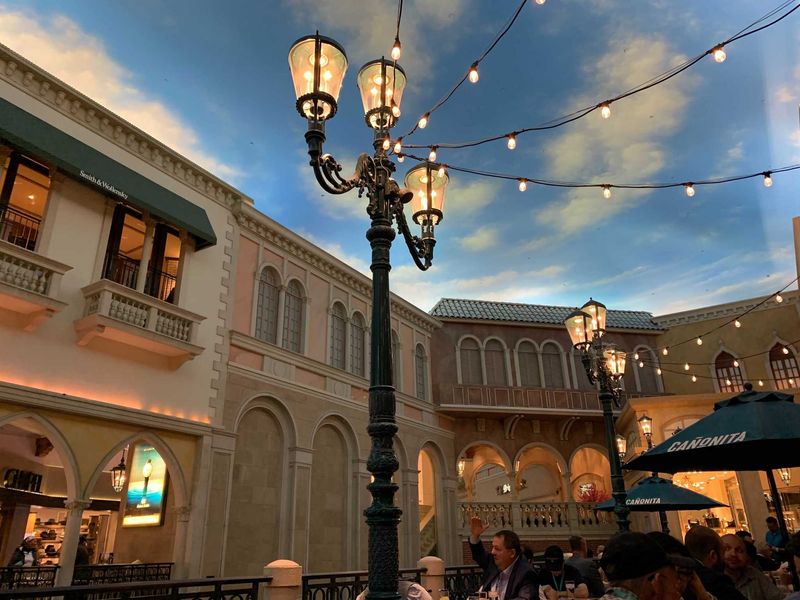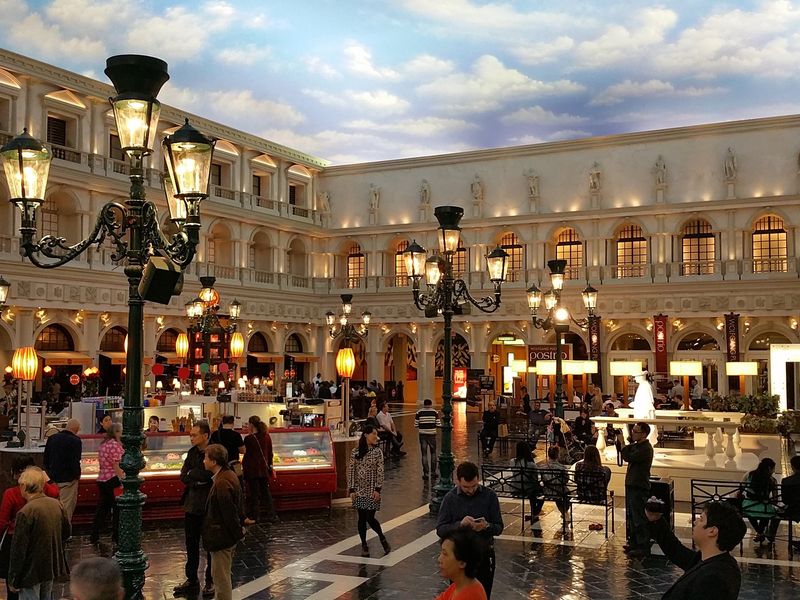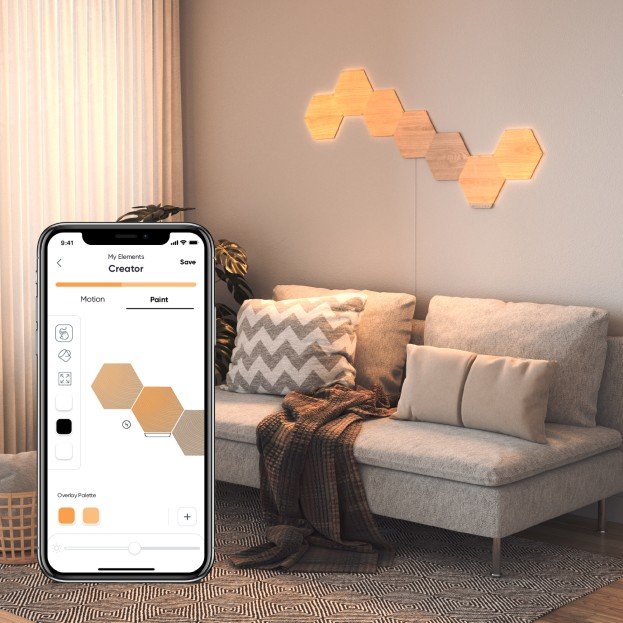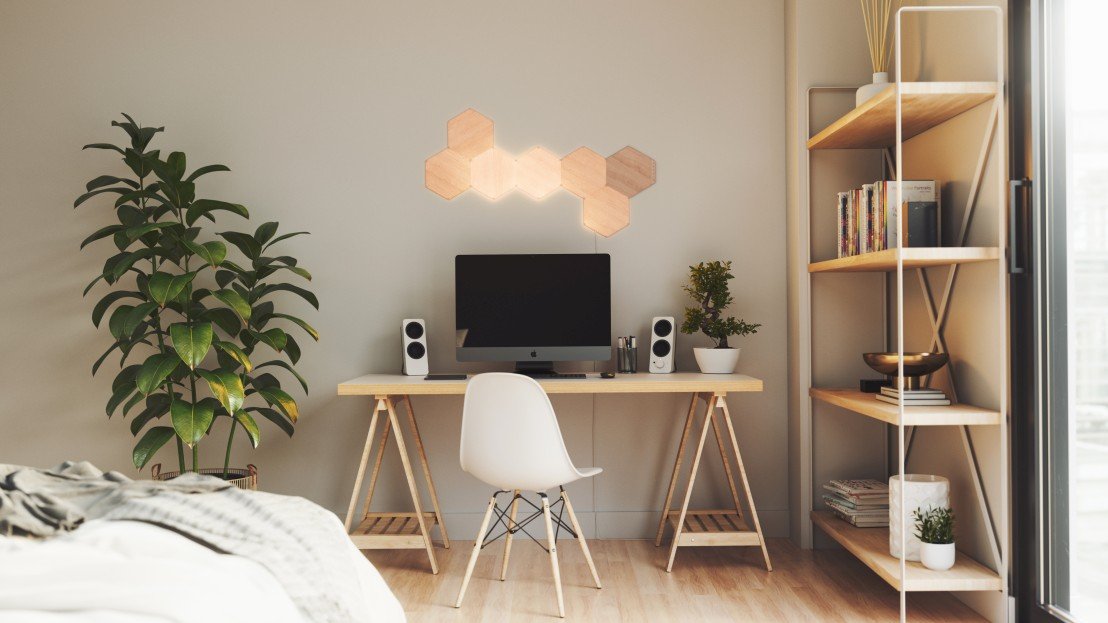A more practical look at a futuristic light source.
If you've ever watched a tech-focused video on YouTube, you've undoubtedly spotted them glowing on a wall somewhere. Nanoleaf is ubiquitous in the tech sector, thrilling RGB enthusiasts everywhere with its geometrically perfect, highly customizable glowing nature. But Nanoleaf's new Elements Wood Look product line is totally different from the triangles and hexagons of the past, eschewing RGB aesthetics for a much more natural look, all without forgetting about what makes Nanoleaf's products truly great — their products always seem to make the list of best smart lights no matter the category.
I sat down virtually with Nanoleaf CEO Gimmy Chu to discuss a bit of Nanoleaf's past, a smattering of Nanoleaf's present, and a look ahead to the future of the company and the smart home industry, as a whole. Having just come from the announcement of the Elements Wood Look line, Chu was practically glowing with excitement from the possibilities that products like Elements Wood Look can bring to design.
Forging new bonds
Android Central: I distinctly recall that Nanoleaf's uniquely designed lights were the first smart light that made me really stop and think about the possibilities that smart lighting could bring to a home. What were your inspirations for the original's design?
Gimmy Chu: Our original Kickstarter project looked very different from what you see from Nanoleaf right now. After that project ended, we wondered: Why are we still creating light bulbs in this shape? We started thinking about how we would create a new kind of light that would look and act differently, drawing inspiration from places like The Venetian in Las Vegas, which has this painted sky inside that's illuminated in a unique way.
We also thought about the Aurora Borealis and how the Northern Lights look and ended up coming up with the original light panels based on those ideas. To sum it up, the inspiration was the sky. It's the best form of light and the most natural expression we could make.
The images above show the way diffused lighting at The Venetian in Las Vegas creates a more natural atmosphere.
Android Central: It's nearly impossible to watch tech YouTube channels without seeing a Nanoleaf set somewhere. Do you think the radically different aesthetic will help push Nanoleaf Elements into ubiquitous territory among other industries and settings?
Gimmy Chu: Elements caters to the design community who are looking for various different inspirations for design. It draws inspiration from the "modern farmhouse chic" design aesthetic that's popular right now. Oftentimes, the products in these markets don't have smart technology built-in. With Nanoleaf Elements, we're focusing on a more "design-first" feel and adding in our unique technology. When it's off, it looks more like a piece of art than a piece of technology, which we think will help bring it to a broader audience that wouldn't normally be interested in a smart home product like this.
Elements is our first step in that direction of using textures as another unique aspect of design.
Android Central: White lighting seems to go very well with wood, whereas I imagine the colors of previous Nanoleaf kits probably wouldn't work so well. Are you working with other materials or color combinations? Can you talk about any that you are working with currently or have in the past?
Gimmy Chu: The idea started with the crackling glow of a fireplace. In a fireplace, you can see parts that glow deep red. We realized that the warm white to the cool white was a really good spectrum, and you could actually kind of simulate different types of wood. In this case, white lighting behind wood turned out to be a better way to get the effect.
With elements, we were thinking a lot about texture. Texture is one of those fundamental aspects of design. Wood was our obvious first choice, but something like marble could be interesting. Even within wood, there are different wood grains and types, so I think that Elements is our first step in that direction of using textures as another unique aspect of design.
Android Central: The way Elements Wood Look is lit appears to be backlit and seems to bring these lights to life in a truly mesmerizing way. How did this idea come about and evolve into what we see in Nanoleaf Elements now?
Gimmy Chu: Elements is corner lit, which gives Element a different lighting quality than our other Nanoleaf sets. Each corner is individually addressable and gives it a more organic feel. It was designed around the concept of Perlin noise, which is something that actually occurs a lot in nature, and it has this sort of movement and motion that's totally unique. That's something that works really well with these individually controllable LEDs.
The idea is that you don't see the light source but, rather, it emits a really soft, organic light that's made to reduce glare.
The idea is that you don't see the light source but, rather, it emits a really soft light that's made to reduce glare. When you have a light bulb, no one wants to look directly at it because it hurts your eyes. With our panels, you could look directly at them because it's completely diffused, and it just creates really soft lights — again, similar to the sky, because that's basically what the sky does to the Sun's light.
Android Central: Nanoleaf's triangle and hexagon shapes are a trademark look for the product. Has Nanoleaf experimented with other shapes or planning on introducing additional shapes and sizes in the future?
Gimmy Chu: We did previously launch a product a couple of years back called Canvas, which was made up of squares, but triangles and hexagons seem to work best when designing a light that can have a custom overall shape. With Elements, the most obvious additional shape we would probably introduce in a future product would be a rectangle because it could be used similarly to flooring or bricks, conceptually. We haven't necessarily decided on where we want to go with that just yet, though.
Android Central: What's your favorite Nanoleaf shape, and why?
Gimmy Chu: The triangle is my favorite because it's the simplest shape possible. No matter how you put modular panels together, they end up looking really, really cool. With triangles, you can form hexagons, so you don't necessarily even need a hexagonal shape by itself; you just need enough triangles in order to create it. Hexagons, of course, have their benefits, and I think they fit better with the wood product, anyway.
Android Central: What's your favorite part of the Elements line?
Gimmy Chu: There's a little bit of a glow to them that other lights don't have. We made that intentionally because it looks really cool and is very different from the previous RGB lineup, which has very clear lines and comes to a stop, whereas the wooden panels emit a distinct glow. Really, just the overall mixture of something simple like wooden panels with technology and how it came together.
Connecting the smart home with Matter and Thread
Android Central: Moving into Nanoleaf's interaction with other smart home products, can you tell me what makes Nanoleaf special compared to some other ambient smart lights, like LED lighting strips?
Gimmy Chu: We really believe as a product company that we need to strive to push the boundaries of technologies rather than just create products that already exist on the market. We make high-quality, cutting-edge products at as affordable a price as we can. Anything we launch or create, we want to make sure that the underlying technology is something we can believe in. With Nanoleaf Elements, there's no other product like it on the market. With our light panels lineup, they were the first of their kind.
Android Central: Looking at current and future integration in the smart home, can you speak about Nanoleaf's input into the newly announced Matter and Thread standards?
Gimmy Chu: With our Nanoleaf Essentials bulbs, we pushed the boundaries by introducing Thread-enabled light bulbs. We were one of the first — if not the first — consumer lighting companies that began using this standard in our products. We're working very closely with the group creating Matter, including Apple and Google, and that's the value we add in our products and something we believe strongly in.
With Matter coming up and Thread being introduced, there's so much that's still in flux. Matter will make it easy for anyone to make smart products, but product companies just making something "connected" doesn't make that product special. There needs to be more value-added to these products to make them better. With our essentials products, we're introducing the ability to play these simple scenes where if you have our light panels and our light bulbs in the same room, they're all kind of working together to create a cohesive feeling.
Our Elements and Shapes controllers will act like a Thread border router — the first of their kind of the market.
One of the things we announced today is that our Elements and Shapes controllers will act like a Thread border router. You could buy third-party Thread devices and have them operate off these routers without any additional configuration. This will work with any additional Thread border routers to enhance a home's Thread network. Our border router will be open, meaning anyone can connect to it, unlike a Zigbee hub where only permitted brands can be on it.
The traffic is totally transparent and owned by the user, not monitored by Nanoleaf. There are several companies that have been talking to us about doing testing with our border router to ensure interoperability, and that's one of the biggest benefits of Thread. We're also going to be working on getting existing Nanoleaf products upgraded to support Matter, but that won't come out until at least Q4 of this year.
Android Central: How do you foresee Nanoleaf being able to take advantage of these new standards, given that Matter is officially launching later this year? If so, do you have any specific examples or ideas to better utilize interconnectivity with other smart home devices?
Gimmy Chu: Matter has four platforms that have to be supported — platforms are something like Google Home, Amazon Alexa, Apple HomeKit, etc. — but with Matter, supporting these individual platforms isn't complicated like it used to be. You don't have to create special code. They're all just supported right away when you use Matter. So with that requirement being thrown out the window, I think the specialized applications or functionality you're looking for are currently being developed and implemented in the operating system on your phone.
How do we move the smart home beyond early adopters? The answer is that we have to put the design first rather than the tech.
I envision that other platforms will be coming out to introduce specialized functionality in the future, as well. Matter shifts the baseline up and gets rid of the novelty of having a connected product, which will force companies to create better-connected products in a more meaningful way.
With Elements, we wanted to focus on industries and segments of the market that have thus far been underserved when it comes to connected tech. When we designed it, we were thinking, "How do we move the smart home beyond early adopters?" The answer is that we have to put the design first rather than the tech. Matter and Thread's inclusion into this equation helps fill out a fuller picture of a future smart home where devices aren't a novelty; they're expected and transparent.
Source: androidcentral

